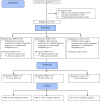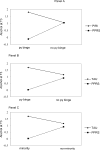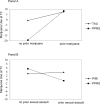A Randomized Clinical Trial Examining the Effect of Video-Based Prevention of Alcohol and Marijuana Use Among Recent Sexual Assault Victims
- PMID: 28940320
- PMCID: PMC5711597
- DOI: 10.1111/acer.13505
A Randomized Clinical Trial Examining the Effect of Video-Based Prevention of Alcohol and Marijuana Use Among Recent Sexual Assault Victims
Abstract
Background: This study examined whether a brief video intervention (Prevention of Post-Rape Stress [PPRS]) delivered in the emergency department to recent sexual assault (SA) victims reduced alcohol and marijuana use at 3 points over the course of a 6-month follow-up compared to treatment as usual (TAU) and an active control condition (Pleasant Imagery and Relaxation Instruction [PIRI]). Prior assault history, minority status, and pre-SA substance use also were examined as moderators of intervention efficacy.
Methods: Women aged 15 and older (N = 154) who participated in a post-SA medical forensic examination were randomly assigned to watch the PPRS video (n = 54) or the PIRI video (n = 48) or receive TAU (n = 52) and completed at least 1 follow-up assessment targeted at 1.5 (T1), 3 (T2), or 6 (T3) months following the examination.
Results: Regression analyses revealed that, relative to TAU, PPRS was associated with less frequent alcohol use at 6 months post-SA among women reporting pre-SA binge drinking and minority women. Relative to TAU, PPRS also was associated with fewer days of marijuana use at T1 among those who did not report pre-SA marijuana use and prior SA. Findings for pre-SA marijuana use were maintained at T3; however, findings for prior SA shifted such that PPRS was associated with fewer days of marijuana use at T3 for women with a prior SA.
Conclusions: PPRS may be effective at reducing substance use for some recent SA victims, including those with a prior SA history, a prior substance use history, and minority women.
Keywords: RCT; Alcohol; Brief Intervention; Marijuana; Sexual Assault.
Copyright © 2017 by the Research Society on Alcoholism.
Conflict of interest statement
The authors have no conflicts of interest to declare.
Figures




Similar articles
-
Prescription Opioid Misuse After a Recent Sexual Assault: A Randomized Clinical Trial of a Video Intervention.Am J Addict. 2019 Sep;28(5):376-381. doi: 10.1111/ajad.12922. Epub 2019 Jun 26. Am J Addict. 2019. PMID: 31242340 Free PMC article. Clinical Trial.
-
Post-sexual assault cigarette smoking: Findings from a randomized clinical trial of a video-based intervention.Addict Behav. 2020 Jan;100:106121. doi: 10.1016/j.addbeh.2019.106121. Epub 2019 Sep 5. Addict Behav. 2020. PMID: 31622944 Free PMC article. Clinical Trial.
-
Post-Sexual Assault Mental Health: A Randomized Clinical Trial of a Video-Based Intervention.J Interpers Violence. 2021 Nov;36(21-22):10614-10637. doi: 10.1177/0886260519884674. Epub 2019 Nov 9. J Interpers Violence. 2021. PMID: 31709903 Free PMC article. Clinical Trial.
-
Psychological Outcomes After a Sexual Assault Video Intervention: A Randomized Trial.J Forensic Nurs. 2015 Jul-Sep;11(3):129-36. doi: 10.1097/JFN.0000000000000080. J Forensic Nurs. 2015. PMID: 26291847 Clinical Trial.
-
Assault related substance use as a predictor of substance use over time within a sample of recent victims of sexual assault.Addict Behav. 2012 Aug;37(8):914-21. doi: 10.1016/j.addbeh.2012.03.017. Epub 2012 Mar 21. Addict Behav. 2012. PMID: 22521363 Free PMC article.
Cited by
-
The Association Between Type of Sexual Assault and Post-Assault Alcohol Misuse Is Moderated by Avoidance Among Recipients of a Sexual Assault Medical Forensic Examination.J Stud Alcohol Drugs. 2019 Sep;80(5):507-514. doi: 10.15288/jsad.2019.80.507. J Stud Alcohol Drugs. 2019. PMID: 31603751 Free PMC article.
-
Psychosocial interventions for survivors of rape and sexual assault experienced during adulthood.Cochrane Database Syst Rev. 2023 Oct 5;10(10):CD013456. doi: 10.1002/14651858.CD013456.pub2. Cochrane Database Syst Rev. 2023. PMID: 37795783 Free PMC article. Review.
-
Acute mental health symptoms among individuals receiving a sexual assault medical forensic exam: the role of previous intimate partner violence victimization.Arch Womens Ment Health. 2020 Feb;23(1):81-89. doi: 10.1007/s00737-019-0947-1. Epub 2019 Feb 14. Arch Womens Ment Health. 2020. PMID: 30762148 Free PMC article.
-
Secondary prevention for posttraumatic stress and related symptoms among women whohave experienced a recent sexual assault: A systematic review and meta-analysis.Depress Anxiety. 2020 Oct;37(10):1047-1059. doi: 10.1002/da.23030. Epub 2020 May 22. Depress Anxiety. 2020. PMID: 32442345 Free PMC article.
-
Prescription Opioid Misuse After a Recent Sexual Assault: A Randomized Clinical Trial of a Video Intervention.Am J Addict. 2019 Sep;28(5):376-381. doi: 10.1111/ajad.12922. Epub 2019 Jun 26. Am J Addict. 2019. PMID: 31242340 Free PMC article. Clinical Trial.
References
-
- Avegno J, Mills TJ, Mills LD. Sexual assault victims in the emergency department: analysis by demographic and event characteristics. The Journal of Emergency Medicine. 2009;37:328–334. - PubMed
-
- Black MC, Basile KC, Breiding MJ, Smith SG, Walters ML, Merrick MT, Stevens M. National intimate partner and sexual violence survey. Atlanta, GA: Centers for Disease Control and Prevention; 2011. p. 75.
-
- Bryan AE, Norris J, Abdallah DA, Stappenbeck CA, Morrison DM, Davis KC, George WH, Danube CL, Zawacki T. Longitudinal change in women’s sexual victimization experiences as a function of alcohol consumption and sexual victimization history: A latent transition analysis. Psychology of violence. 2016;6:271–279. - PMC - PubMed
-
- de Meneses-Gaya C, Zuardi AW, Loureiro SR, Crippa JAS. Alcohol Use Disorders Identification Test (AUDIT): An updated systematic review of psychometric properties. Psychology & Neuroscience. 2009;2:83–97.
Publication types
MeSH terms
Grants and funding
LinkOut - more resources
Full Text Sources
Other Literature Sources
Medical

